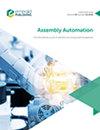Minimizing deviations of car sequencing in a JIT production painting line
IF 1.7
4区 计算机科学
Q3 AUTOMATION & CONTROL SYSTEMS
引用次数: 2
Abstract
Purpose The first in first out (FIFO) rule is an indispensable rule in the automotive industry. However, during production, the order of coming to welding operation and exiting through the painting operation is broken. Consequently, the rule of FIFO also gets broken. The purpose of this paper is to eliminate the deviations of the automotive painting process in a just in time (JIT) environment. Design/methodology/approach The paper has been solved using observations and expert’s opinions and recorded data in the real problem area. Bypass technique and express line have been used as a real problem for the minimization of these deviations. The current process and the bypass process have been compared with simulation optimization. Findings This paper provides analytical insights about how to prevent delays during the JIT production painting process. Delays have been prevented by using the bypass technique and express line together. The number of delays reduced with an improvement of 129. The ratio of effect (for four months) has been founded to be 0.12. The output rate has been increased from 80% to 89%. Research limitations/implications This paper focused on the number of vehicles in the cooling area of the painting process in the study; there may occur bottleneck processes or products. It does not contain station-based bottleneck processes. Practical implications From the real-case problem, one will see that the bypass technique and the express line can be applied and generalized to many similar problems and help companies conduct their assembly lines more efficiently. Originality/value This paper is the only example that has been used to bypass technique and express line together on the paint/cooling process in a JIT production system.在准时制喷漆生产线上最小化车辆排序偏差
先进先出(FIFO)规则是汽车工业中不可或缺的规则。然而,在生产过程中,进入焊接操作和通过涂装操作退出的顺序被打破。因此,先进先出的规则也被打破了。本文的目的是在准时制(JIT)环境中消除汽车涂装工艺的偏差。设计/方法论/方法利用实际问题领域的观察、专家意见和记录数据解决了这篇论文。旁路技术和快线已经被用作最小化这些偏差的实际问题。对现有工艺和旁路工艺进行了仿真优化比较。发现本文提供了关于如何在JIT生产涂装过程中防止延误的分析见解。通过将旁路技术和快线结合使用,避免了延误。延迟次数减少,改进了129次。效果的比率(对于四 月)已经确定为0.12。产出率从80%提高到89%。研究局限性/含义本文重点研究了涂装过程中冷却区的车辆数量;可能会出现瓶颈过程或产品。它不包含基于工作站的瓶颈进程。实际意义从实际问题中,我们可以看到旁路技术和快线可以应用和推广到许多类似的问题中,并帮助企业更有效地进行装配。独创性/价值本文是JIT生产系统中唯一一个在油漆/冷却过程中使用旁路技术和流水线的例子。
本文章由计算机程序翻译,如有差异,请以英文原文为准。
求助全文
约1分钟内获得全文
求助全文
来源期刊

Assembly Automation
工程技术-工程:制造
CiteScore
4.30
自引率
14.30%
发文量
51
审稿时长
3.3 months
期刊介绍:
Assembly Automation publishes peer reviewed research articles, technology reviews and specially commissioned case studies. Each issue includes high quality content covering all aspects of assembly technology and automation, and reflecting the most interesting and strategically important research and development activities from around the world. Because of this, readers can stay at the very forefront of industry developments.
All research articles undergo rigorous double-blind peer review, and the journal’s policy of not publishing work that has only been tested in simulation means that only the very best and most practical research articles are included. This ensures that the material that is published has real relevance and value for commercial manufacturing and research organizations.
 求助内容:
求助内容: 应助结果提醒方式:
应助结果提醒方式:


